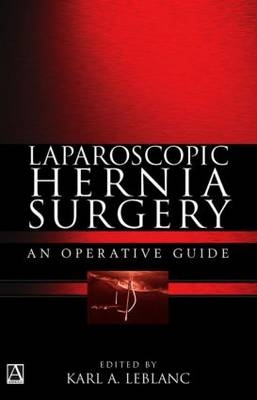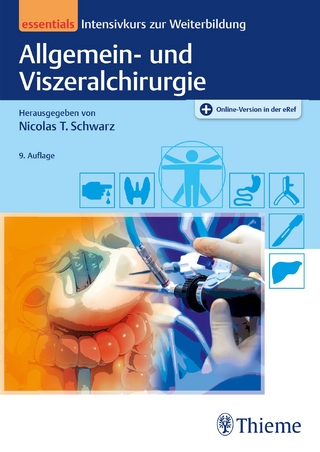
Laparoscopic Hernia Surgery
Hodder Arnold (Verlag)
978-0-340-80940-2 (ISBN)
- Titel ist leider vergriffen;
keine Neuauflage - Artikel merken
Repair of simple and complex abdominal hernias by the laparoscopic technique is now the method of choice in many centres. Laparoscopic repair offers equivalent outcomes to open repair, with the additional benefits of greater patient satisfaction and reduced hospitalization. For some hernias, notably incisional and hiatal, the outcome appears to be superior using the minimally invasive technique.
This book, authored by an international team of leading surgeons in the field of hernia repair, gives a definitive guide to appropriate patient selection and operative technique. The introductory section delivers a useful, illustrated account of instrumentation, biomaterials and mesh fixation. Subsequent sections provide detailed information about inguinal, incisional and hiatal herniorraphy, including four chapters devoted to the use of laparoscopy in the pediatric patient. Robotics and the socio-economic aspects of hernia surgery are also discussed.
- The book gives in-depth coverage of each surgical procedure, including essential background information, relevant anatomy, preoperative evaluation of the patient, choice of instrumentation and biomaterials, and cosmetic results.
- Each procedure is illustrated with a step-by-step series of high-quality laparoscopic photographs, allowing the reader to follow the sequence of the operation.
- The recognition and management of complications is highlighted, and successful postoperative management techniques are also considered.
Instructional, descriptive and illustrated in colour throughout, this unrivalled operative guide offers a complete analysis of each of the current technologies, and is an invaluable source of information for practicing and trainee surgeons.
Karl A. LeBlanc MD MBA FACS, Minimally Invasive Surgery Institute, Inc., Baton Rouge; Clinical Assistant Professor, Surgery, Louisiana State University School of Medicine, New Orleans, Louisiana, USA; past president of the American Hernia Society.
Part One – Overview
1.Laparoscopic General Surgery
2.Technical and Instrumentation Aspects of Laparoscopic Hernia Surgery
3.Prosthetic Biomaterials for hernioplasty
4.Fixation devices for laparoscopic hernioplasty
Part Two – Laparoscopic Inguinal/Femoral Hernioplasty
5.History
6.Anatomy and physiology
7.Intraperitoneal onlay mesh approach
8.Transabdominal pre-peritoneal approach
9.Totally extraperitoneal approach
10.Femoral and pelvic herniorraphy
11.Results of laparoscopic inguinal/femoral hernia repair
12.Complications and their management
Part Three – Laparoscopic incisional and ventral hernioplasty
13.History
14.Anatomy and physiology
15.Laparoscopic repair in the emergent setting
16.Herniorraphy with the use of transfascial sutures
17.Pre-peritoneal herniorraphy
18.Hernioplasty with the â€÷double-crown†technique
19.Paracstomal hernia repair
20.Lumbar hernia and "denervation" hernia repair
21.Results of laparoscopic incisional and ventral hernia repair
22.Complications and their management
Part Four – Laparoscopic treatment of diaphragmatic herniation
23.History
24.Anatomy and physiology
25.Preoperative evaluation
26.Gastroesophageal reflux disease
27.Para-esophageal hernias
28.Traumatic and unusual herniation
29.Etiology of recurrent gastroesophageal reflux disease
30.Reoperation for recurrent gastroesophageal reflux disease
31.Results of laparoscopic treatment of hiatal hernias
32.Complications and their management
Part Five – Laparoscopy in the pediatric hernia patient
33.History
34.Anatomy and physiology
35.Diaghramatic herniation
36.Complications and their management
Part Six – Future considerations
37.Robotics and hernia surgery
38.Socioeconomic issues
| Erscheint lt. Verlag | 29.8.2003 |
|---|---|
| Zusatzinfo | 48 line; 26 B&W tone; 191 colour tone |
| Verlagsort | London |
| Sprache | englisch |
| Maße | 202 x 270 mm |
| Themenwelt | Medizin / Pharmazie ► Allgemeines / Lexika |
| Medizinische Fachgebiete ► Chirurgie ► Viszeralchirurgie | |
| ISBN-10 | 0-340-80940-X / 034080940X |
| ISBN-13 | 978-0-340-80940-2 / 9780340809402 |
| Zustand | Neuware |
| Haben Sie eine Frage zum Produkt? |
aus dem Bereich


